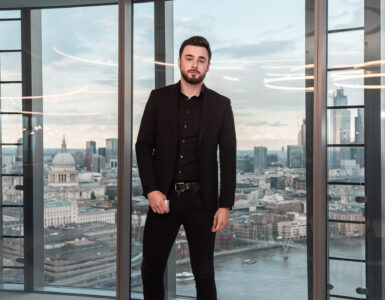Pavel Belov, the former innovation head at MegaFon, a Russian telecom giant, relocated to Berlin with his family in August 2022.
There, while tackling German lessons, Belov noticed a gap in the language learning app market – a lack of AI-powered chatbots. So, he and his partner Ilya Shreyder built their own in two weeks.
Fast forward, and Belov launched his company GPT4Telegrambot Inc. last year and his AI chatbot has reached over 12 million users worldwide with a team of just three people, offering everything from image generation to code creation, all on the Telegram platform.
While Microsoft, Apple and other tech giants are aggressively adding more and more AI-based features that could threaten more startups with each new announcement and update, this does not stop entrepreneurs like Belov from seeing opportunities in curating a growing plethora or AI products in new ways for everyday users.
Icebreaker spoke to Belov, who is still based in Berlin, about what made their chatbot a Telegram success, their growth plans, and why they are not planning to raise any funding.

Icebreaker: Can you describe your main product and what it does for an audience that doesn’t use Telegram every day?
‘All in one’ AI bot can be used to generate text, video, code, music, song, images, edit images, avatars, create summaries of YouTube videos – it’s an aggregator.
Tell me more about your MegaFon experience and what you worked on there?
A lot of AI chatbots, including virtual assistant Eva that answered calls on behalf of customers if they didn’t want to pick up. She could understand speech well and could have a conversation with you. It [the work with chatbots] started in 2019.
How did the idea for the first ‘all in one’ chatbot come about?
After OpenAI launched ChatGPT, I started searching for it on Telegram, based on my experience with virtual assistant Eva. Then I was convinced that it’s possible to do a Telegram-based application, without using a separate web platform or mobile app. Telegram is a great platform for simple, intuitive interface.
Right now 900 million people are using Telegram around the world every month. The messenger platform is not as popular in the U.S. and Europe, but is crazy popular in developing countries, the Middle East, Latin America, Central Asia, Africa – there are nearly a billion people who use it each month.
So the idea was to use ChatGPT as a Telegram bot to help me learn German, to ask it quick questions because I was familiar with the Telegram interface. And when I didn’t find such a bot, after a couple of weeks, my partner and I decided to launch it.
How fast did your Telegram channel grow?
It was magic. The first day had a thousand users, the second day we had 5,000 users. In terms of marketing, my wife and I wrote Facebook posts. We launched it at the end of January, and my birthday is on March 24. My wife and I joked that we wanted to reach a million users by my birthday. It was a joke – but in the end by April, a little after my birthday, we did reach a million users.
Then in the fall of 2023 we decided to add other verticals, the first one was media. As a media company, we cover the most recent news in AI, also publishing interviews with interesting entrepreneurs or highlight case studies.
So now we have three channels. The first one is the Chatbot where we post updates, most important news about AI. The ‘Hi AI Media’ has 450,000 people in Russian and 150,000 people in English.
The third vertical is education, we’re doing a large course on neural networks, we built over 100 lessons. It’s targeted at a general audience. Now we see most of the courses are either paid subscribers or highly specialized audiences like marketing specialists or developers.
We think that there is space for a course for everyday people, teachers, students, housewives, retired people, doctors–- it’s the most basic course for a general audience about how neural networks can help you in your everyday life. Students are recording videos targeted at students, while scientists are recording videos targeted at them.
What are your plans for monetization?
We’re monetizing already, almost from the very beginning. The company is profitable. We offer access to ChatGPT 3.5 for free, and then we offer different options for paid services. 1.5% of our users are paid subscribers.
How big is your team?
We have three founders. I’m responsible for the product and business side. I also curate the editorial side. My partner Ilya is responsible for technical side and development. And Anya [Anna Veklich], my wife, handles marketing and the education verticals.
What do you attribute the success of your Telegram channel to?
I think we found good distribution channels, took excellent products and we curated them in a place that’s convenient for users.
Telegram is a great tool for micro services, and we were the first to do it for the AI chatbot and were able to grow fast. Then a few similar services popped up, but by that point already had a significant user base.
You said you’re profitable already. Do you still plan to raise funds?
We didn’t plan to. We had an acquisition offer, but we decided not to sell right now. We’re moving towards a marketplace model inside Telegram. Our goal is to create a marketplace of AI-powered services. The idea is to support this marketplace through our media channels and educational courses, expanding gradually to cover new markets. We’re actively looking at Brazil, our audience is growing fast there.
In North America, Telegram is not the dominant messaging platform because there is Facebook Messenger, WhatsApp, Signal, Discord, a lot of options. In Latin America, Telegram is growing actively. So we also have opportunities to grow where Telegram is growing.
Where do you see your product in a year or so? What kind of goals are you looking to reach now?
It’s hard to imagine. We didn’t expect to reach 12.5 million users in a year. It’s difficult to project what comes next. For the daily active users metric is the most important, the most interesting metric that shows it’s being used.
Now we’ve reached 600,000 DAU, as the next milestone I’d like to reach 1 million. That would be the accurate measure, a sign that we’re moving in the right direction. We’re also looking to grow revenue, add services and expand to new markets.






Add comment